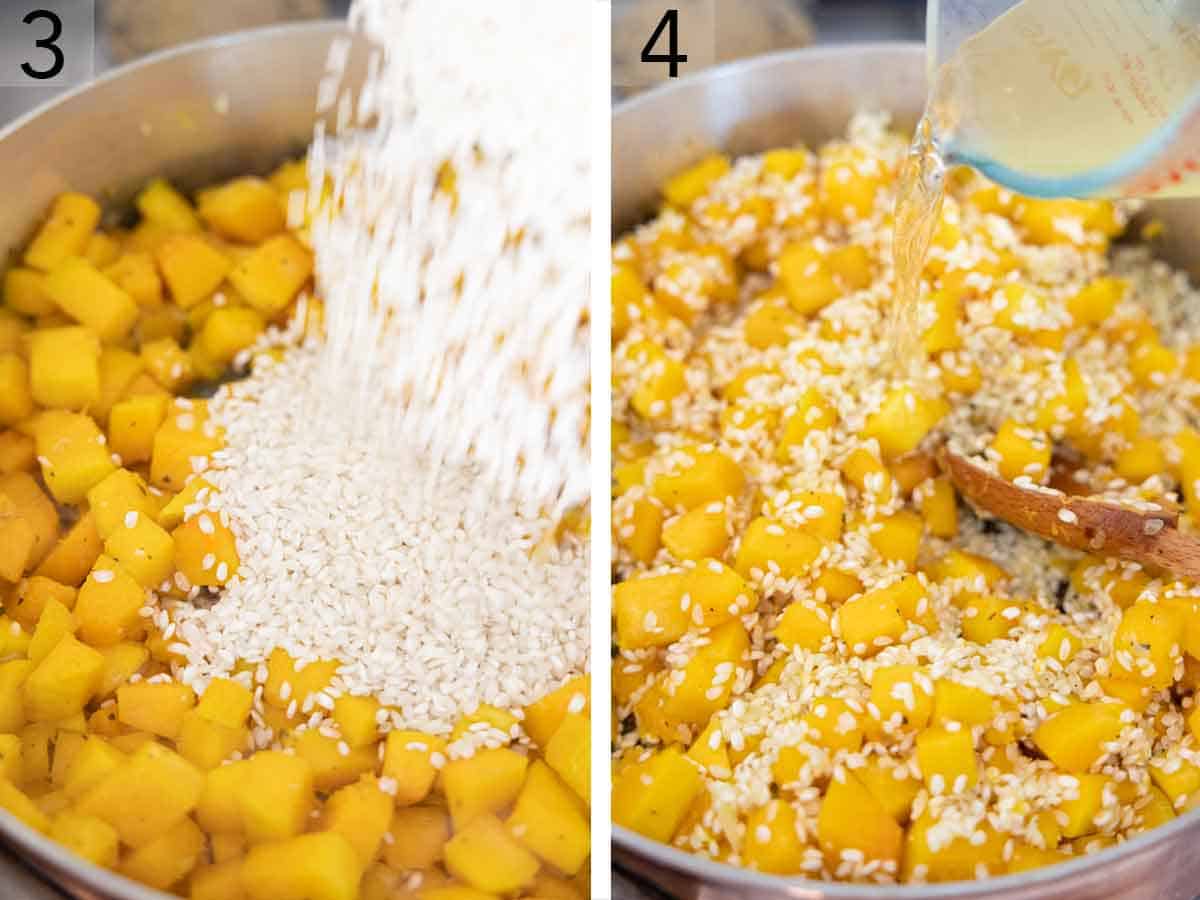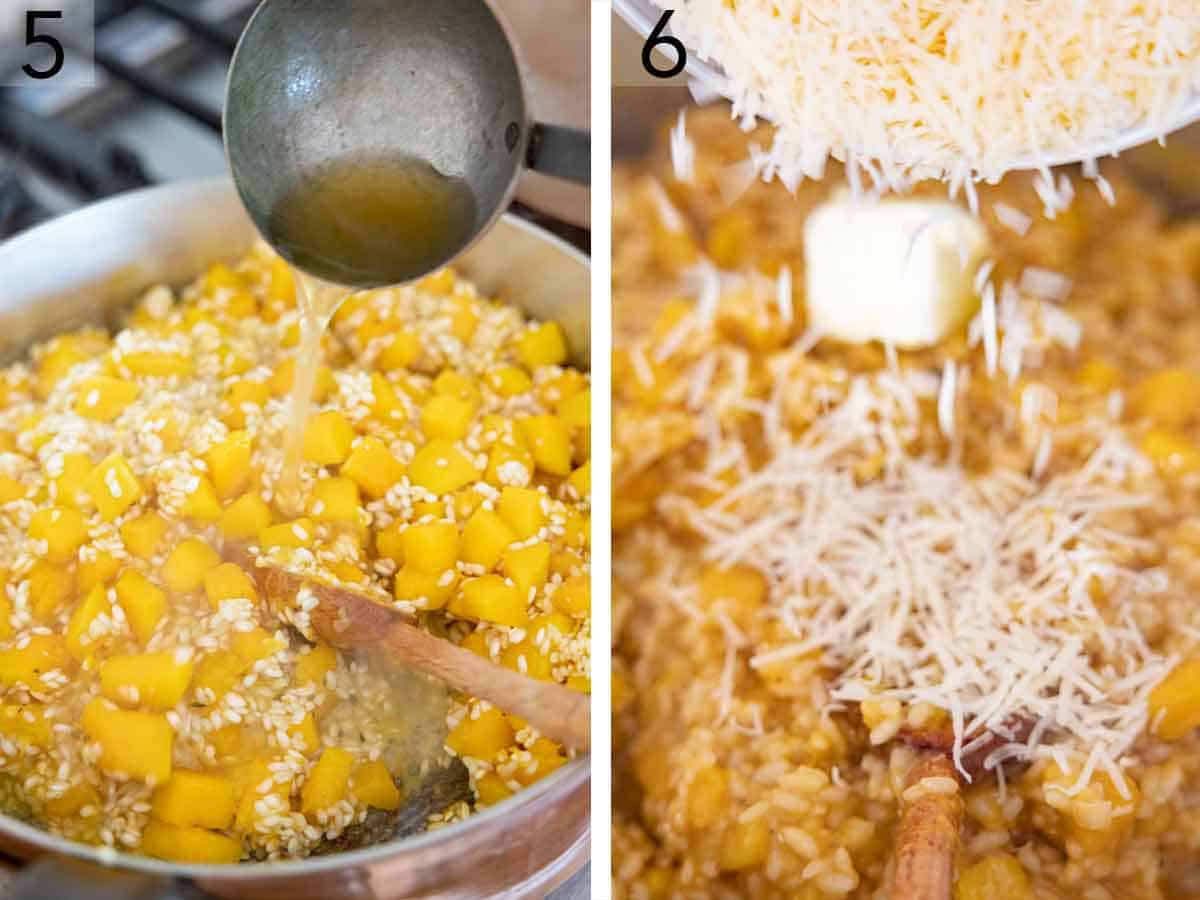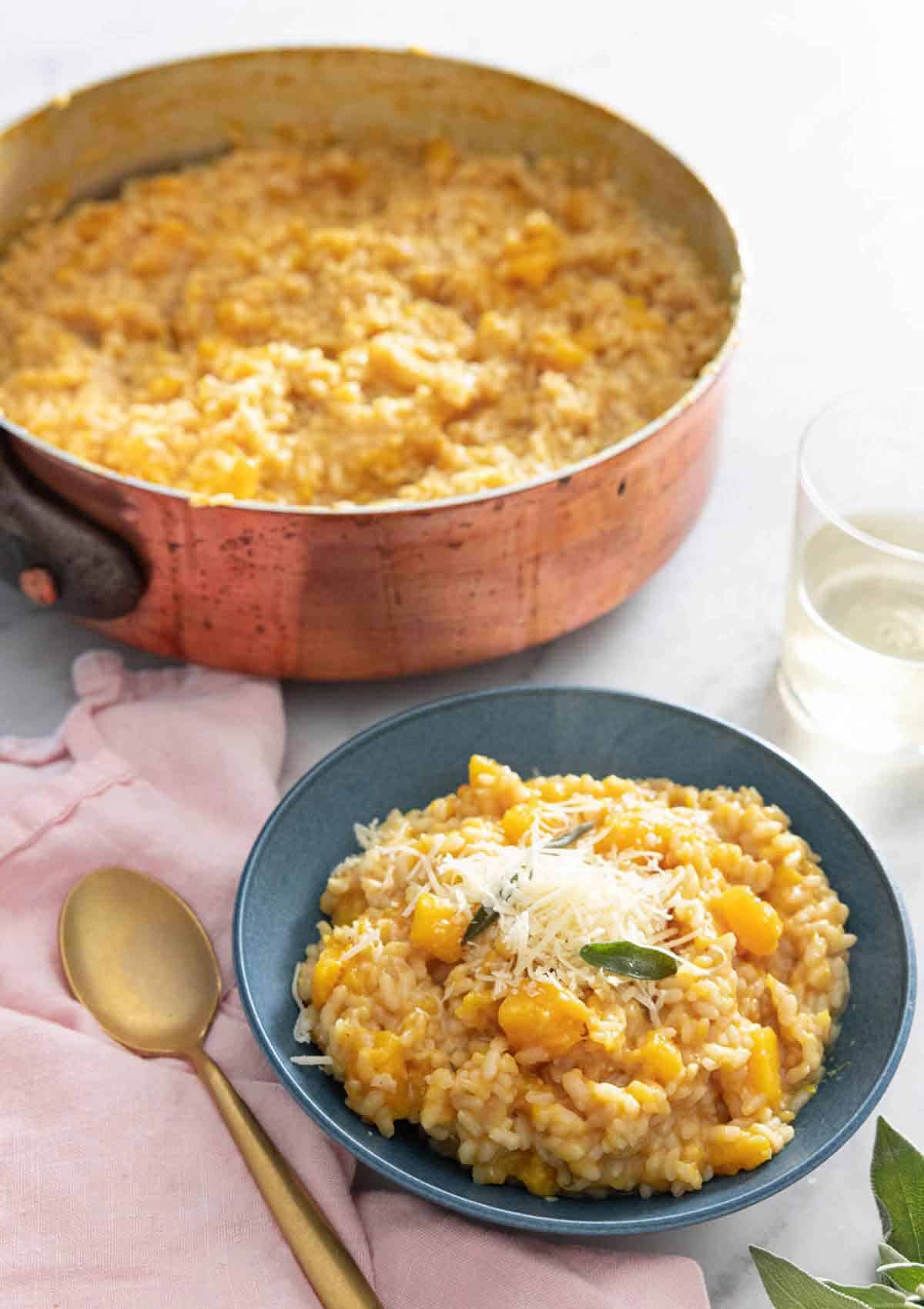Making risotto may seem challenging at first as it’s a very hands-on recipe. However, there is nothing complicated about this homemade butternut squash risotto at all! All you have to do is slowly add everything to a pan, stirring constantly, and you’ll end up with a dreamy bowl of risotto in no time. Most of the labor involved is just stirring, so the rice doesn’t burn. Trust me, it’s super easy, and it’ll leave your dinner guests impressed.
If you love the flavors of butternut squash, then you are going to love this risotto. And if you have extra butternut squash, try adding butternut squash mac and cheese or making this easy butternut squash soup.
What You Need to Make This Recipe

Vegetable broth — if possible, use low sodium or no salt added broth. This will make it easier for you to control how salty your squash risotto will be.
Butternut squash — to tell if your squash is ripe, check for an even matte coloring. If there are green spots and it’s glossy, it is not ready to cook with. If the skin is wrinkly or the stem has fallen off, skip buying that one as it’s past its prime.
Arborio rice — this is an Italian short-grain rice that becomes firmer, chewier, and creamier than regular rice when cooked. There isn’t a distinct flavor to the rice, so it absorbs flavors it’s cooked with very well.
White wine — this provides a kick of acidity to the risotto. Be sure to use a wine that is of good quality. If you wouldn’t drink it, then don’t use it in cooking. If you do not want to use wine, add a squeeze of fresh lemon juice to add acidity and substitute the rest of the liquid amount with broth.
How to Make Butternut Squash Risotto

1. Heat the broth in a large saucepan over medium-low heat until steaming.
2. In a large, high-sided skillet, heat a tablespoon of oil over medium heat and cook the onion and garlic. Then add the remaining tablespoon of oil, butternut squash, sage, ½ teaspoon salt, and ¼ teaspoon pepper. Cook, occasionally stirring until lightly browned and tender.

3. Add the rice, and cook, often stirring, until the edges of the rice are translucent, about 2 minutes.
4. Stir in the wine, and stir until completely absorbed.

5. Add one ladle of warm broth to the rice. Cook, constantly stirring until the broth is almost completely absorbed. Repeat the process, adding one ladle of broth at a time until the rice is thickened, tender, and creamy.
6. Remove from the heat, and stir in the parmesan, butter, remaining ½ teaspoon salt, and remaining ¼ teaspoon pepper until smooth.

Pro Tips for Making This Recipe
- The broth cannot be cold, so do not skip warming it up at the beginning. Adding cold broth to the pan will disrupt the cooking process of the arborio rice, and it may cook unevenly.
- Risotto is not a dish you can walk away from as you cook. The risotto will stick to the bottom of the pan and burn if you do not stir the dish throughout the cooking process.
- Avoid keeping the risotto on the stove while adding the cheese, as it can lead to an overly thick and dry risotto.
- Do not rush the process by adding all the broth into the pan at once. Waiting for the rice to absorb the broth before adding more is what leads to the creamy texture.
- Dicing the butternut squash to the same size will allow it to cook evenly throughout. The easiest way to dice the squash is by cutting off the top and bottom ends, peeling it, then cutting it into quarters. Then, you can quickly dice the squash as it’s a more manageable size.

Frequently Asked Questions
What do you serve with squash risotto?
This butternut squash risotto makes for a great Thanksgiving side dish, so it goes well with turkey. This risotto also goes well with seared scallops, shrimp, and salmon. You can stir in some shredded chicken into the risotto as well! If you’re serving this risotto as a main dish, you can serve a fresh salad and some homemade focaccia alongside it.
How do I store leftovers?
Store leftover risotto in the fridge for 2 to 3 days. It’s important when reheating risotto that it’s hot all the way through. You also may need to add a little extra broth to loosen it when reheating.
Can you freeze butternut risotto?
You can! If you have extra risotto and want to save it for another day, freeze the risotto in a freezer-safe bag or container once it has cooled. When ready to eat, defrost it in the fridge overnight, and gently reheat it on the stovetop, stirring frequently. Add a splash of broth as you stir the risotto to loosen it.
Can I make this vegan?
You can make this squash risotto vegan in a few simple swaps. Swap the butter for vegan butter and use vegan cheese instead of parmesan cheese.
Can I use frozen butternut squash?
If you don’t have fresh butternut squash, you can substitute it with frozen squash. Simply thaw it before using.
Can I use any type of rice?
No, for this squash risotto, you must use arborio rice to achieve that creamy texture.
If you’ve tried this Butternut Squash Risotto recipe, then don’t forget to rate the recipe and let me know how you got on in the comments below, I love hearing from you!

Butternut Squash Risotto
Equipment
- Large skillet
- Ladle
Ingredients
- 8 cups vegetable broth (1920mL)
- 2 tablespoons olive oil divided
- ½ small yellow onion finely chopped
- 1 tablespoon minced garlic (3 cloves)
- 1 small butternut squash peeled, seeded, and cut into 1/2-inch pieces (1 1/2-pounds)
- 1 teaspoon chopped sage plus additional leaves to garnish
- 1 teaspoon salt divided
- ½ teaspoon black pepper divided
- 2 cups arborio rice (440g)
- ½ cup dry white wine (120mL)
- 1 cup grated parmesan cheese plus additional for garnish (80g)
- 3 tablespoons unsalted butter
Instructions
- Heat the broth in a large saucepan over medium-low heat until steaming.
- In a large, high-sided skillet, heat 1 tablespoon of oil over medium heat. Add the onion. Cook, stirring often, until tender, about 3 minutes. Add the garlic and cook, stirring constantly, until fragrant, about 30 seconds. Add the remaining 1 tablespoon oil, butternut squash, sage, ½ teaspoon salt, and ¼ teaspoon pepper. Cook, stirring occasionally, until lightly browned and tender, about 6 minutes.
- Add the rice, and cook, stirring often, until the edges of the rice are translucent, about 2 minutes. Stir in the wine, and stir until completely absorbed, about 1 minute.
- Add one ladle (about ½ cup) of warm broth to the rice. Cook, stirring constantly, until the broth is almost completely absorbed. Repeat the process, adding one ladle of broth at a time, until the rice is thickened, tender, and creamy, about 25 to 30 minutes total.
- Remove from the heat, and stir in the parmesan, butter, remaining 1/2 teaspoon salt, and remaining ¼ teaspoon pepper until smooth. Garnish with additional sage leaves and additional parmesan, if desired.
Notes
- The broth cannot be cold, so do not skip warming it up at the beginning. Adding cold broth to the pan will disrupt the cooking process of the arborio rice, and it may cook unevenly.
- Risotto is not a dish you can walk away from as you cook. The risotto will stick to the bottom of the pan and burn if you do not stir the dish throughout the cooking process.
- Avoid keeping the risotto on the stove while adding the cheese, as it can lead to an overly thick and dry risotto.
- Do not rush the process by adding all the broth into the pan at once. Waiting for the rice to absorb the broth before adding more is what leads to the creamy texture.
- Dicing the butternut squash to the same size will allow it to cook evenly throughout. The easiest way to dice the squash is by cutting off the top and bottom ends, peeling it, then cutting it into quarters. Then, you can quickly dice the squash as it’s a more manageable size.
Nutrition















Ava says
I adore fried sage
Katherine says
Beautiful risotto!